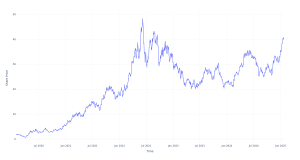By Samuel Indyk and Rae Wee
LONDON (Reuters) -The dollar (DX=F) rose on Monday, driving its peers to multi-year lows, after Friday’s blowout U.S. jobs report underscored the strength of the economy and muddied the outlook for further Federal Reserve rate cuts this year.
The greenback surged to its highest in more than two years on Monday against a basket of currencies to peak at 110.08, extending last week’s rally.
Friday’s data showed U.S. job growth unexpectedly accelerated in December and the unemployment rate fell to 4.1%, leaving traders heavily scaling back bets of Federal Reserve rate cuts this year.
Markets were now no longer fully pricing in even one rate cut from the Fed this year, down from roughly two quarter-point cuts priced at the start of the year.
With Wednesday’s reading on U.S. inflation up next, any upside surprise could threaten to close the door on easing altogether. A slew of Fed officials are also due to speak this week.
“If you look back at the last year there were worries and signs that there were cracks in the labour market emerging, but they seem to have been fully plastered, not just papered over,” said Dominic Bunning, head of G10 FX strategy at Nomura.
“The U.S. economy is resilient enough to justify a strong dollar and justify relatively higher rates.”
Adding to expectations of a less aggressive easing cycle is the view that President-elect Donald Trump’s plans for hefty import tariffs, tax cuts and immigration restrictions could stoke inflation. He returns to the White House in a week.
The euro hit its weakest level against the dollar since November 2022 at $1.0177, while sterling was one of the biggest losers, sliding as much as 0.7% to a 14-month low of $1.2107.
The pound has been under pressure from concerns over rising borrowing costs and growing unease over Britain’s finances. It tumbled 1.8% last week.
“The overriding view remains that the UK government will probably be forced to announce spending cuts on 26 March,” said Chris Turner, global head of markets at ING.
“This will feed into a tighter fiscal/looser monetary/weaker sterling narrative.”
Elsewhere, the Australian dollar sank to its weakest since April 2020 at $0.6131. The New Zealand dollar last traded at $0.5553, languishing near a more than two-year low.
Beijing steps in
The yuan meanwhile bucked the global trend and rose slightly on Monday after Beijing stepped up efforts to defend the weakening currency by relaxing rules to allow more offshore borrowing and sending verbal warnings.



